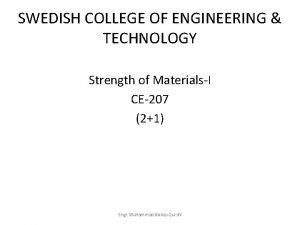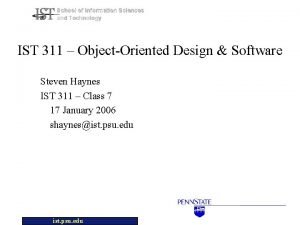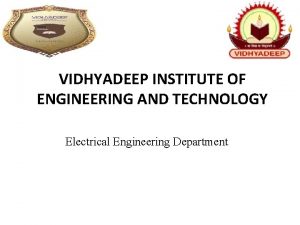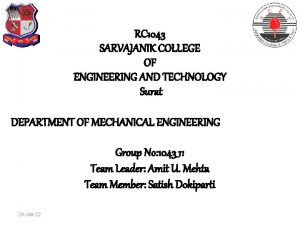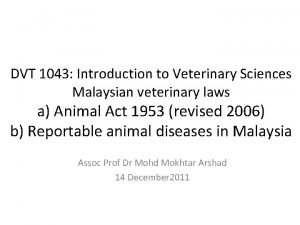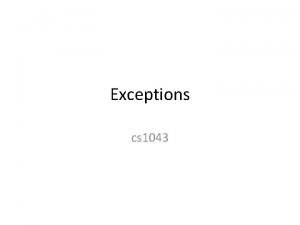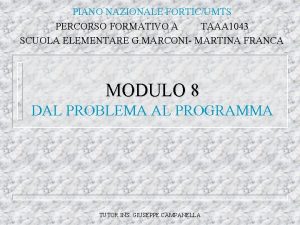RC 1043 SARVAJANIK COLLEGE OF ENGINEERING AND TECHNOLOGY








- Slides: 8

RC 1043 SARVAJANIK COLLEGE OF ENGINEERING AND TECHNOLOGY Surat DEPARTMENT OF MECHANICAL ENGINEERING Group No: 1043_11 Team Leader: Amit U. Mehta Team Member: Satish Dokiparti

Problem 1: Draw locus of a point on the periphery of a circle which rolls on straight line path. Take circle diameter as 50 mm. Steps: 1) From center C draw a horizontal line equal to D distance. 2) Divide D distance into 12 number of equal parts and name them C 1, C 2, C 3__ etc. 3) Divide the circle also into 12 number of equal parts and in clock wise direction, after P name 1, 2, 3 up to 12. 4) From all these points on circle draw horizontal lines. (parallel to locus of C) 5) With a fixed distance C-P in compass, C 1 as center, mark a point on horizontal line from 1. Name it P. 6) Repeat this procedure from C 2, C 3, C 4 upto C 12 as centers. Mark points P 2, P 3, P 4, P 5 up to P 8 on the horizontal lines drawn from 1, 2, 3, 4, 5, 6, 7 respectively. 7) Join all these points by curve. It is Cycloid. p 6 6 p 5 p 7 7 5 p 8 4 p 4 8 C 1 9 p 3 p 2 10 12 P C 3 C 4 C 5 C 6 C 7 C 8 C 9 C 10 p 9 C 11 C 12 3 p 10 2 p 1 11 C 2 p 11 p 12 1 D

Problem 2: Draw locus of a point on the periphery of a circle which rolls on a curved path. Take diameter of rolling circle 50 mm and radius of directing circle 75 mm. Generating/ Rolling Circle 5 4 3 C 1 6 C 1 C 3 C 4 C 5 7 2 P C 7 r = CP C 2 C 6 Directing Circle C R 8 = r 3600 R + Steps: 1) when smaller circle will roll on larger circle for one revolution it will cover D distance on arc and it will be decided by included arc angle . 2) calculate by formula = (r/R) x 360°. 3) construct angle with radius OC and draw an arc by taking O as center OC as radius and form sector of angle . 4) divide this sector into 8 number of equal angular parts. And from C onward name them C 1, C 2, C 3 up to C 8. 5) divide smaller circle (generating circle) also in 8 number of equal parts. And next to P in clockwise direction name those 1, 2, 3, up to 8. 6) with o as center, o-1 as radius draw an arc in the sector. Take O-2, O-3, O-4, O-5 up to O-8 distances with center O, draw all concentric arcs in sector. Take fixed distance C-P in compass, C 1 center, cut arc of 1 at P 1. Repeat procedure and locate p 2, p 3, p 4, p 5 unto p 8 (as in cycloid) and join them by smooth curve. This is EPI – CYCLOID. O

P 7 P 1 6 P 2 1 C C 2 C 1 P 3 2 C 3 C 4 5 C 6 4 3 P 4 C 7 P 5 P 6 C 8 = r 3600 R + Steps: 1) smaller circle is rolling here, inside the larger circle. It has to rotate anticlockwise to move ahead. 2) same steps should be taken as in case of epi – cycloid. Only change is in numbering direction of 8 number of equal parts on the smaller circle. 3) from next to p in anticlockwise direction, name 1, 2, 3, 4, 5, 6, 7, 8. 4) further all steps are that of epi – cycloid. This is called Hypo – cycloid. Problem 3: Draw locus of a point on the periphery of a circle which rolls from the inside of a curved path. Take diameter of Rolling circle 50 mm and radius of directing circle 75 mm. O OC = R ( Radius of Directing Circle) CP = r (Radius of Generating Circle) P 7 P 8

P 2 P 3 to p 1 t op 3 2 to p P 1 4 to p 4 3 5 op 6 to p P 5 2 6 5 t Steps: 1) Point or end P of string AP is exactly D distance away from A. Means if this string is wound round the circle, it will completely cover given circle. B will meet A after winding. 2) Divide D (AP) distance into 8 number of equal parts. 3) Divide circle also into 8 number of equal parts. 4) Name after A, 1, 2, 3, 4, etc. up to 8 on D line AP as well as on circle (in anticlockwise direction). 5) To radius C-1, C-2, C-3 up to C-8 draw P 4 tangents (from 1, 2, 3, 4, etc to circle). 6) Take distance 1 to P in compass and mark it on tangent from point 1 on circle (means one division less than distance AP). 7) Name this point P 1 8) Take 2 -B distance in compass and mark it on the tangent from point 2. Name it point P 2. 9) Similarly take 3 to P, 4 to P, 5 to P up to 7 to P distance in compass and mark on respective tangents and locate P 3, P 4, P 5 up to P 8 (i. e. A) points and join them in smooth curve it is an INVOLUTE of a given circle. Problem no 4: Draw Involute of a circle. String length is equal to the circumference of circle. P 6 7 7 to p 1 A 8 P 7 1 2 3 4 D 5 6 7 P 8

Problem 5: Draw a spiral of one convolution. Take distance PO 40 mm. 2 Solution Steps 1. With PO radius draw a circle and divide it in eight parts. Name those 1, 2, 3, 4, etc. up to 8 2. Similarly divided line PO also in eight parts and name those 1, 2, 3, -- as shown. 3. Take o-1 distance from op line and draw an arc up to O 1 radius vector. Name the point P 1 4. Similarly mark points P 2, P 3, P 4 up to P 8 and join those in a smooth curve. It is a SPIRAL of one convolution. P 2 3 P 1 1 P 3 P 4 4 O P 5 7 6 P 7 5 4 3 2 1 P 6 7 5 6 P

Problem 6: Point P is 80 mm from point O. It starts moving towards O and reaches it in two revolutions around. It Draw locus of point P (To draw a Spiral of TWO convolutions). 2, 10 P 2 P 1 3, 11 Steps: 1. Total angular displacement here is two revolutions And 2. Total Linear displacement here is distance PO. 3. Just divide both in same parts i. e. Circle in eight parts. (means total angular displacement in sixteen parts) 4. Divide PO also in sixteen parts. Rest steps are similar to the previous problem. 1, 9 P 3 P 10 P 9 P 11 4, 12 P 4 16 P 12 10 8 7 6 5 4 3 2 1 P P 8 8, 16 P 15 P 13 P 14 P 7 P 5 5, 13 13 P 6 6, 14 7, 15

 Thakur college of engineering and technology
Thakur college of engineering and technology Fnu engineering courses
Fnu engineering courses Animals that eat both plants and animals
Animals that eat both plants and animals Swedish college of engineering and technology
Swedish college of engineering and technology Ist 311
Ist 311 Trent global college of technology and management
Trent global college of technology and management Vidhyadeep institute of engineering and technology
Vidhyadeep institute of engineering and technology Fcc office of engineering and technology
Fcc office of engineering and technology Accreditation board for engineering and technology
Accreditation board for engineering and technology



